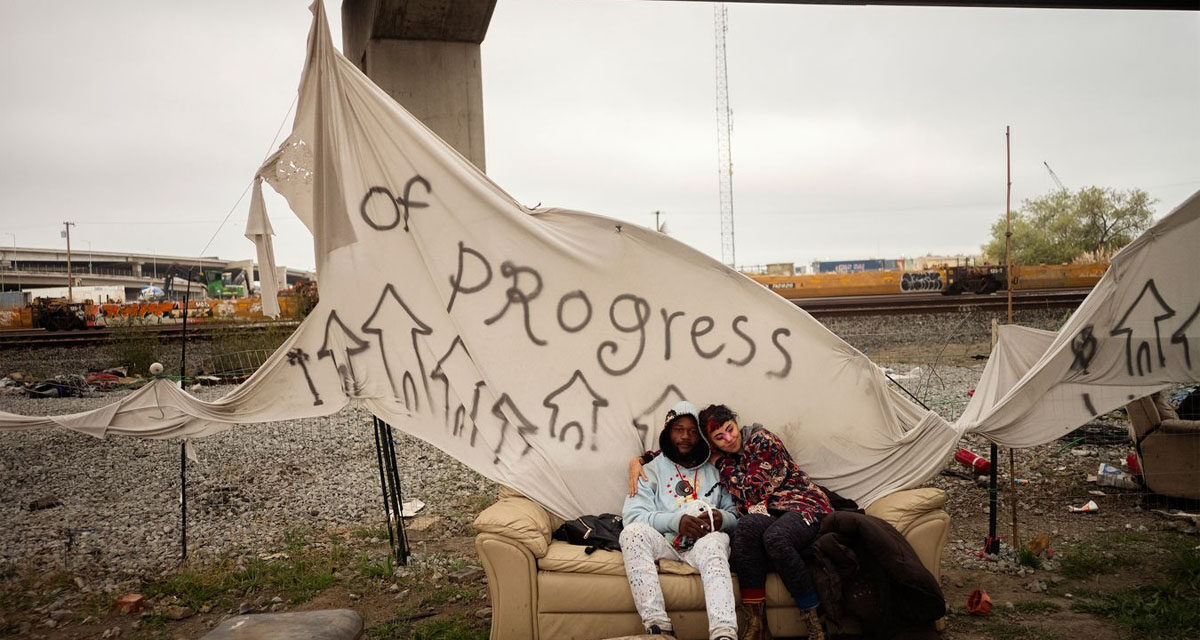
WSJ: California’s $17 Billion Investment Against Homelessness a Complete Failure

In a land of golden dreams and soaring ambitions, one problem continues to defy the best-laid plans and untold resources: homelessness. The state of California, known for its innovation and wealth, has been grappling with an escalating crisis for years, spending a staggering $17 billion in the past four fiscal years alone. However, as the smoke clears from the Wood Street encampment fire, it becomes painfully clear that these efforts have not yielded the desired results.
The Wood Street encampment, nestled beneath the Interstate 880 freeway, had become a makeshift home for over 300 individuals, representing a cross-section of society grappling with addiction, mental illness, and economic hardship. The fire that ravaged the encampment last summer forced authorities to confront the issue head-on, prompting discussions and legal battles that exposed the challenges faced by both officials and the homeless population.
California, accounting for 12% of the nation’s population, shoulders an overwhelming burden, harboring nearly half of the United States’ unsheltered homeless individuals, estimated at 115,000 people according to data from last year. This alarming statistic is further compounded by the state’s exorbitant housing costs, making it increasingly difficult for individuals to secure stable shelter.
The Wood Street encampment fire marked a turning point in the battle against homelessness in California, compelling the California Department of Transportation to initiate the dismantling of the makeshift shelters. However, a protracted legal and bureaucratic struggle ensued, illuminating the complex web of humanitarian, practical, and political forces that have stymied progress in addressing this urgent issue.
Responsibility for housing the displaced individuals fell on the city of Oakland, which claimed it lacked sufficient shelter beds. Even those fortunate enough to secure federal housing vouchers faced insurmountable challenges finding affordable apartments. Meanwhile, many residents of Wood Street, afflicted by addiction and mental illness, were resistant to relocating, preferring the freedom of their encampment over the restrictions imposed by shelters.
A federal lawsuit filed by 30 individuals sought to challenge the closure of the Wood Street encampment. Those who had rejected offers of alternative housing, citing concerns about leaving their pets or possessions behind, argued against the abrupt displacement. However, after months of legal wrangling, the court ruled against them, leaving the Wood Street residents in a precarious position.
The fire department’s staggering record of responding to 816 fires at homeless camps in Oakland within a year, including 63 at Wood Street, highlights the urgent need for a comprehensive and effective solution. Reginald Freeman, the city fire chief at the time, astutely observed, “When you have these homes that are fabricated, and you have open flames, there’s going to be fire incidents.” It is clear that the current approach is not sustainable, both from a humanistic perspective and in terms of public safety.
Despite the unprecedented financial investment of $17 billion in the past four years, with an additional $3.7 billion proposed for the upcoming fiscal year, the results have been underwhelming. Voters in cities like Los Angeles and San Francisco, recognizing the severity of the crisis, have approved substantial taxes to fund anti-homelessness programs and housing. Yet, cost overruns and delays have hindered progress, leaving many disillusioned.
The blame game between state and local officials further compounds the problem. Governor Gavin Newsom has threatened to withhold funding from local governments he perceives as lacking urgency in tackling homelessness. Local leaders, on the other hand, argue that stable funding and additional resources are necessary to effectively address the issue.
“The false assumption that mandated treatment works better than voluntary treatment, and nothing could be further from the truth,” said Erlenbusch.
Reisig acknowledges that treatment should be a crucial component of addressing addiction, but he argues that without consequences for drug possession, individuals are less likely to seek help voluntarily. The proposal aims to create a system that incentivizes individuals to choose treatment and rehabilitation over continued drug use.
Critics of the proposal raise concerns about the potential criminalization of addiction, arguing that it would exacerbate the cycle of homelessness and incarceration. They emphasize the need for a comprehensive approach that addresses the underlying causes of homelessness, such as affordable housing and mental health support.
As the debate continues, activists and advocates for the homeless emphasize the need for a more holistic and compassionate approach. Merely displacing individuals and pushing them from one location to another without addressing the underlying causes of homelessness is a futile endeavor.
The proposed solution put forward by Yolo County’s district attorney, focusing on cracking down on hard drug possession, sparks controversy. While some argue that stricter drug laws could help curb addiction and ultimately reduce homelessness, others caution against criminalizing addiction and advocate for a more supportive and rehabilitative approach.
Ultimately, the solution to California’s homelessness crisis may lie in a multifaceted approach that combines affordable housing initiatives, mental health support, addiction treatment programs, and a commitment from both state and local governments to allocate resources effectively.
As the debate rages on, the challenge remains: how can a state with vast resources and innovation continue to grapple with a crisis of this magnitude? The answer lies not in quick fixes or surface-level measures but in a genuine commitment to addressing the underlying issues and offering a helping hand to those in need.
Editor’s note: For the amount of money being spent, they could almost literally hire a police office to follow around each homeless person and make sure they don’t do drugs. California’s mismanagement is out of control and it is causing tremendous economic damage in places like San Francisco, where office building vacancies are at record highs. I would put this squarely on the shoulders of Governor Newsom and certain other “woke” Democrats who have no understanding of human nature and whose actions are hurting a great many people.
























Thats easy to figure out. Just ask yourself whos in charge.
This is a very hard problem for any state to solve, let alone trying to solve it in the state filled with fruits and nuts!
Tom, very well put!